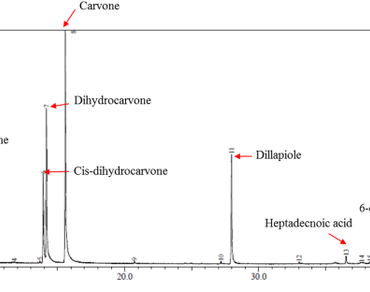GC-MS analysis of essential oil and exploration of Anethum graveolens extracts for antimicrobial and antioxidant activity
*Article not assigned to an issue yet
Research Articles | Published: 12 April, 2024
Online ISSN : 2229-4473.
Website:www.vegetosindia.org
Pub Email: contact@vegetosindia.org
First Page: 0
Last Page: 0
Views: 1021
Keywords:
Aromatic, Bioremediation, Free radical, Nanoparticles, Toxic
Abstract
The present study investigated the chemical composition of essential oil obtained from Anethum graveolens seeds, one of the under explored crop. The evaluation for antimicrobial activity revealed that the essential oil exhibited MIC value of 0.02% (v/v) against Bacillus cereus and Staphylococcus epidermidis, 0.05% (v/v) against S. aureus, 0.1% (v/v) against Listeria monocytogenes, 0.5% (v/v) against Escherichia coli and 1.0% (v/v) against Pseudomonas aeruginosa, respectively. Essential also exhibited the antifungal activity against Fusarium oxysporum and Sclerotinia sclerotiorum. The current study also investigated the biosynthesis of silver nanoparticles using A. graveolens leaves extracts followed by their role in free radical scavenging and antimicrobial activity. It was observed that the silver nanoparticles exhibited a free radical scavenging IC value of 40 µg ± 3 per ml of DPPH. Moreover, the plant extract used for silver nanoparticle biosynthesis also mitigated the toxic effect of silver at 1mM to 10mM. Thus, the present study indicates that the A. graveolens seeds being rich source of various volatile compounds can be explored for its antimicrobial properties whereas the plant extract could be used for alienating the heavy metal stress based oxidative stress and bioremediation.

(*Only SPR Members can get full access. Click Here to Apply and get access)
References
Aati HY, Perveen S, Aati S et al (2022) Headspace solid-phase microextraction method for extracting volatile constituents from the different parts of Saudi Anethum graveolens L. and their antimicrobial activity. Heliyon 8:e09051. https://doi.org/10.1016/j.heliyon.2022.e09051
Adebayo EA, Ibikunle JB, Oke AM et al (2019) Antimicrobial and antioxidant activity of silver, gold and silver-gold alloy nanoparticles phytosynthesized using extract of Opuntia ficus indica. Rev Adv Mater Sci 58:313–326. https://doi.org/10.1515/rams-2019-0039
Ahmed S, Ahmad M, Swami BL, Ikram S (2016) A review on plants extract mediated synthesis of silver nanoparticles for antimicrobial applications: a green expertise. J Adv Res 7:17–28. https://doi.org/10.1016/j.jare.2015.02.007
Akinola PO, Lateef A, Asafa TB et al (2020) Multifunctional titanium dioxide nanoparticles biofabricated via phytosynthetic route using extracts of Cola nitida: antimicrobial, dye degradation, antioxidant and anticoagulant activities. Heliyon 6:e04610. https://doi.org/10.1016/j.heliyon.2020.e04610
Al-Haidari RA, Shaaban MI, Ibrahim SRM, Mohamed GA (2016) Anti-quorum sensing activity of some medicinal plants. Afr J Tradit Complement Altern Med 13:67–71. https://doi.org/10.21010/ajtcam.v13i5.10
Blank I, Grosch W (1991) Evaluation of potent odorants in dill seed and dill herb (Anethum graveolens L.) by aroma extract dilution analysis. J Food Sci 56:63–67
Grosso C, Ferraro V, Figueiredo AC et al (2008) Supercritical carbon dioxide extraction of volatile oil from Italian coriander seeds. Food Chem 111:197–203. https://doi.org/10.1016/j.foodchem.2008.03.031
Jamal M, Ahmad W, Andleeb S et al (2018) Bacterial biofilm and associated infections. J Chin Med Assoc 81:7–11. https://doi.org/10.1016/j.jcma.2017.07.012
Jana S, Shekhawat GS (2020) Anethum graveolens: An Indian traditional medicinal herb and spice. Pharmacognosy Rev 4(8):179–184. https://doi.org/10.4103/0973-7847.70915
Kartini K, Alviani A, Anjarwati D et al (2020) Process optimization for green synthesis of silver nanoparticles using Indonesian medicinal plant extracts. Processes 8. https://doi.org/10.3390/PR8080998
Keat CL, Aziz A, Eid AM, Elmarzugi NA (2015) Biosynthesis of nanoparticles and silver nanoparticles. Bioresour Bioprocess 2. https://doi.org/10.1186/s40643-015-0076-2
Kharat SN, Mendhulkar VD (2016) Synthesis, characterization and studies on antioxidant activity of silver nanoparticles using Elephantopus scaber leaf extract. Mater Sci Eng C 62:719–724. https://doi.org/10.1016/j.msec.2016.02.024
Lukubye B, Ajayi CO, Wangalwa R, Kagoro-Rugunda G (2022) Phytochemical profile and antimicrobial activity of the leaves and stem bark of Symphonia Globulifera L.f. and Allophylus Abyssinicus. (Hochst) Radlk BMC Complement Med Ther 22:1–20. https://doi.org/10.1186/s12906-022-03692-0
Mahmoodi A, Roomiani L, Soltani M et al (2012) Chemical composition and antibacterial activity of essential oil and extracts from Rosmarinus officinalis, Zataria multiflora, Anethum graveolens and Eucalyptus globulus. Glob Vet 9:73–79
Mseddi K, Alimi F, Noumi E et al (2020) Thymus musilii Velen. As a promising source of potent bioactive compounds with its pharmacological properties: in vitro and in silico analysis. Arab J Chem 13:6782–6801. https://doi.org/10.1016/j.arabjc.2020.06.032
Noumi E, Ahmad I, Adnan M et al (2023) GC/MS Profiling, antibacterial, anti-quorum sensing, and antibiofilm properties of Anethum graveolens L. essential oil: molecular docking study and in-silico ADME Profiling. Plants
Peerakam N, Wattanathorn J, Punjaisee S et al (2014) Chemical profiling of essential oil composition and biological evaluation of Anethum graveolens L. (seed) grown in Thailand. J Nat Sci Res www Iiste org ISSN 4:34–41
Quintero-Quiroz C, Acevedo N, Zapata-Giraldo J et al (2019) Optimization of silver nanoparticle synthesis by chemical reduction and evaluation of its antimicrobial and toxic activity. Biomater Res 23:1–15. https://doi.org/10.1186/s40824-019-0173-y
Radulescu V, Popescu ML (2010) Chemical composition of the volatile oil from different plant parts of Anethum graveolens L. (Umbelliferae) cultivated in Romania chemical composition of the volatile oil from different plant parts of Anethum graveolens L. (umbelliferae) cultivated. Farmacia 4–11
Sánchez-López E, Gomes D, Esteruelas G et al (2020) Metal-based nanoparticles as antimicrobial agents: an overview. Nanomaterials 10:1–39. https://doi.org/10.3390/nano10020292
Sarker SD, Nahar L, Kumarasamy Y (2007) Microtitre plate-based antibacterial assay incorporating resazurin as an indicator of cell growth, and its application in the in vitro antibacterial screening of phytochemicals. Methods 42:321–324. https://doi.org/10.1016/j.ymeth.2007.01.006
Singh A, Gaud B, Jaybhaye S (2020) Optimization of synthesis parameters of silver nanoparticles and its antimicrobial activity. Mater Sci Energy Technol 3:232–236. https://doi.org/10.1016/j.mset.2019.08.004
Singh G, Maurya S, De Lampasona MP, Catalan C (2005) Chemical constituents, antimicrobial investigations, and antioxidative potentials of Anethum graveolens L. essential oil and acetone extract: part 52. J Food Sci 70:208–215. https://doi.org/10.1111/j.1365-2621.2005.tb07190.x
Acknowledgements
Author Information
University Centre for Research and Development, Chandigarh University, Gharuan, Mohali, India
College of Horticulture and Forestry, Dr. YS Parmar University of Horticulture and Forestry, Neri, Hamirpur, India
University Centre for Research and Development, Chandigarh University, Gharuan, Mohali, India
ankvivek@gmail.com